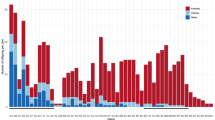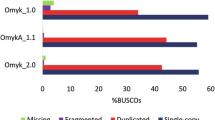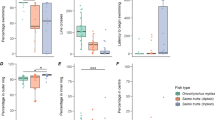Abstract
We have previously reported that rainbow trout (Salmo gairdneri) more heterozygous at enzyme loci generally show increased developmental stability, as measured by reduced fluctuating asymmetry. We experimentally produced gynogenetic diploid and triploid individuals to test the effect of extreme heterozygosities on developmental stability. Gynogenetic diploids are identical by descent at an estimated 34 per cent of all loci and show a 50 per cent increase in the mean proportion of traits asymmetric per individual compared to normal rainbow trout. Triploids from two different strains have an estimated 30 per cent increase in genomic heterozygosity and a 14 per cent decrease in the mean proportion of traits asymmetric per individual compared to normal diploids. These changes in asymmetry induced by gynogenesis and triploidy are not as great as we expected based on the association between heterozygosity and fluctuating asymmetry in random mating populations. The narrow range of mean asymmetry in rainbow trout may result from an upper limit restricted by directional selection for developmental stability and a lower limit determined by inherent randomness in the developmental process.
Similar content being viewed by others
Article PDF
References
Allendorf, F W, and Leary, R F. 1984. Heterozygosity in gynogenetic diploids and triploids estimated by gene-centromere recombination rates. Aquaculture, 42, in press.
Beck, M L, and Biggers, J. 1983. Erythrocyte measurements of diploid and triploid Ctenopharyngodon idella × Hypophthalmichthys nobilis hybrids. J Fish Biol, 22, 497–502.
Benfey, T J, and Sutterlin, A M. 1984. The haematology of triploid landlocked Atlantic salmon, Salmo salar L. J Fish Biol, 24, 333–338.
Brückner, D. 1976. The influence of genetic variability on wing asymmetry in honeybees (Apis mellifera). Evol, 30, 100–108.
Chakraborty, R. 1981. The distribution of the number of heterozygous loci in an individual in natural populations. Genetics, 98, 461–466.
Fankhauser, G. 1945. The effects of changes in chromosome number on amphibian development. Quart Rev Biol, 20, 20–78.
Guyomard, R. 1984. High level of residual heterozygosity in gynogenetic rainbow trout, Salmo gairdneri, Richardson. Theor Appl Genet, 67, 307–316.
Koehn, R K, and Andshumway, S E. 1982. Agenetic/physiological explanation for differential growth rate among individuals of the American oyster, Crassostrea virginica (Gmelin). Marine Biol Letters, 3, 35–42.
Leary, R F. Allendorf, F W, and Knudsen, K L. 1983. Developmental stability and enzyme heterozygosity in rainbow trout. Nature, 301, 71–72.
Leary, R F. Allendorf, F W, and Knudsen, K L. 1984. Superior developmental stability of heterozygotes at enzyme loci in salmonid fishes. Amer Natur, 124, 540–551.
Leary, R F. Allendorf, F W, and Knudsen, K L. 1984. Major morphological effects of a regulatory gene: Pgml-t in rainbow trout. Molec Biol Evol, 1, 183–194.
Leary, R F. Allendorf, F W, and Knudsen, K L. 1985. Inheritance of meristic variation and the evolution of developmental stability in rainbow trout. Evol, 38, In Press.
Leary, R F. Allendorf, F W, and Knudsen, K L. 1985. Developmental instability as an indicator of the loss of genetic variation in hatchery trout. Trans Amer Fish Soc, 114, 222–227.
Lerner, I M. 1954. Genetic homeostasis. Wiley, New York.
Lewis, N E, and Rossant, J. 1982. Mechanism of size regulation in mouse embryo aggregates. J Embryol Exp Morphol, 72, 169–181.
Mather, K. 1953. Genetical control of stability in development. Heredity, 7, 297–336.
Mita, I, and Obata, C. 1984. Timing of early morphogenetic events in tetraploid starfish embryos. J Exper Zool, 229, 215–222.
Purdom, C E. 1983. Genetic engineering by the manipulation of chromosomes. Aquaculture, 33, 287–300.
Reeve, E C R. 1960. Some genetic tests on asymmetry of sternopleural chaeta in Drosophila. Genet Res, 1, 151–172.
Scheerer, P D, and Thorgaard, G H. 1983. Increased survival in salmonid hybrids by induced triploidy. Canad J Fish Aquatic Sci, 40, 2040–2044.
Swarup, H. 1959. Effect of triploidy on the body size, general organization and cellular structure in Gasterosteus aculeatus (L.). J Genet, 56, 143–155.
Thorgaard, G H. 1983. Chromosome set manipulation and sex control in fish. In Fish Physiology 9B, 405–434. Academic Press.
Thorgaard, G. Allendorf, F W, and Knudsen, K L. 1983. Gene-centromere mapping in rainbow trout: high interference over long map distances. Genetics, 103, 771–783.
Thorgaard, G H, and Gall, G A E. 1979. Adult triploids in a rainbow trout family. Genetics, 93, 961–973.
Thorgaard, G H. Jazwin, M E, and Stier, A R. 1981. Polyploidy induced by heat shock in rainbow trout. Trans Amer Fish Soc, 110, 546–550.
Thoday, J M. 1953. Components of fitness. Symp Soc Exper Biol, 7, 96–113.
Van Valen, L. 1962. A study of fluctuating asymmetry. Evol, 16, 125–142.
Waddington, C H. 1942. Canalization of development and the inheritance of acquired characters. Nature, 150, 563–565.
Waddington, C H. 1948. Polygenes and oligogenes. Nature, 151, 395.
Author information
Authors and Affiliations
Rights and permissions
About this article
Cite this article
Leary, R., Allendorf, F., Knudsen, K. et al. Heterozygosity and developmental stability in gynogenetic diploid and triploid rainbow trout. Heredity 54, 219–225 (1985). https://doi.org/10.1038/hdy.1985.29
Received:
Issue date:
DOI: https://doi.org/10.1038/hdy.1985.29
This article is cited by
-
Baseline mRNA expression differs widely between common laboratory strains of zebrafish
Scientific Reports (2018)
-
Chromosomal manipulation in Senegalese sole (Solea senegalensis Kaup, 1858): induction of triploidy and gynogenesis
Journal of Applied Genetics (2015)
-
Biochemical and molecular differences in diploid and triploid ocean-type chinook salmon (Oncorhynchus tshawytscha) smolts
Fish Physiology and Biochemistry (2007)
-
The biology of triploid fish
Reviews in Fish Biology and Fisheries (2004)
-
The relationship between the effects of UV light and thermal shock on gametes and the viability of early developmental stages in a marine teleost fish, the sea bass (Dicentrarchus labrax L.)
Heredity (1999)



